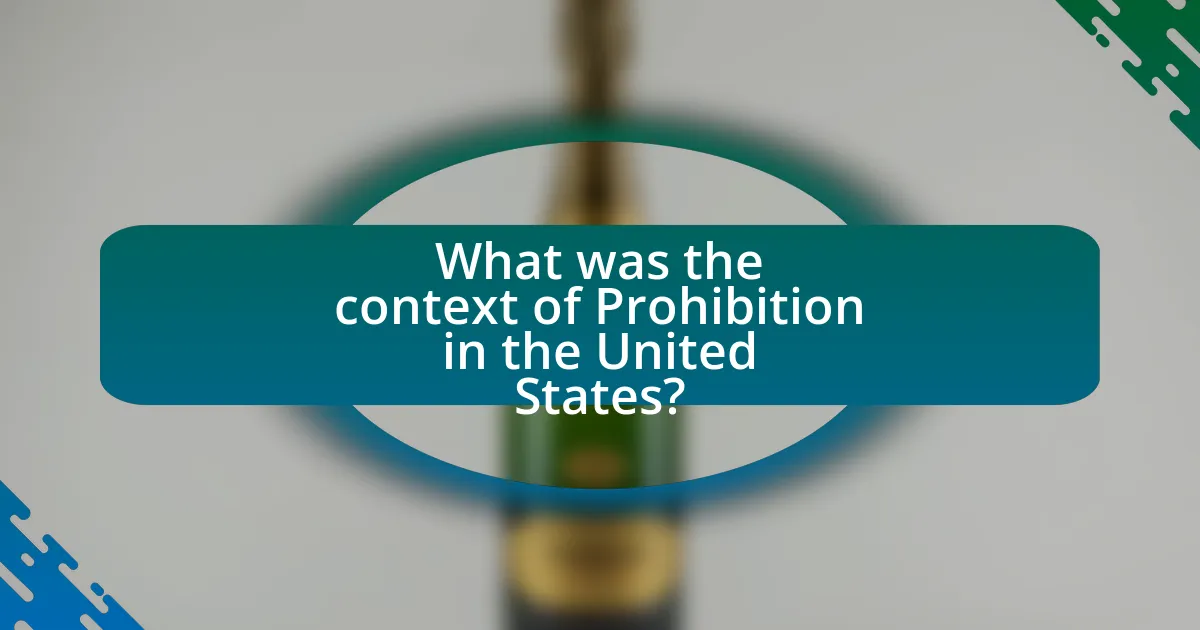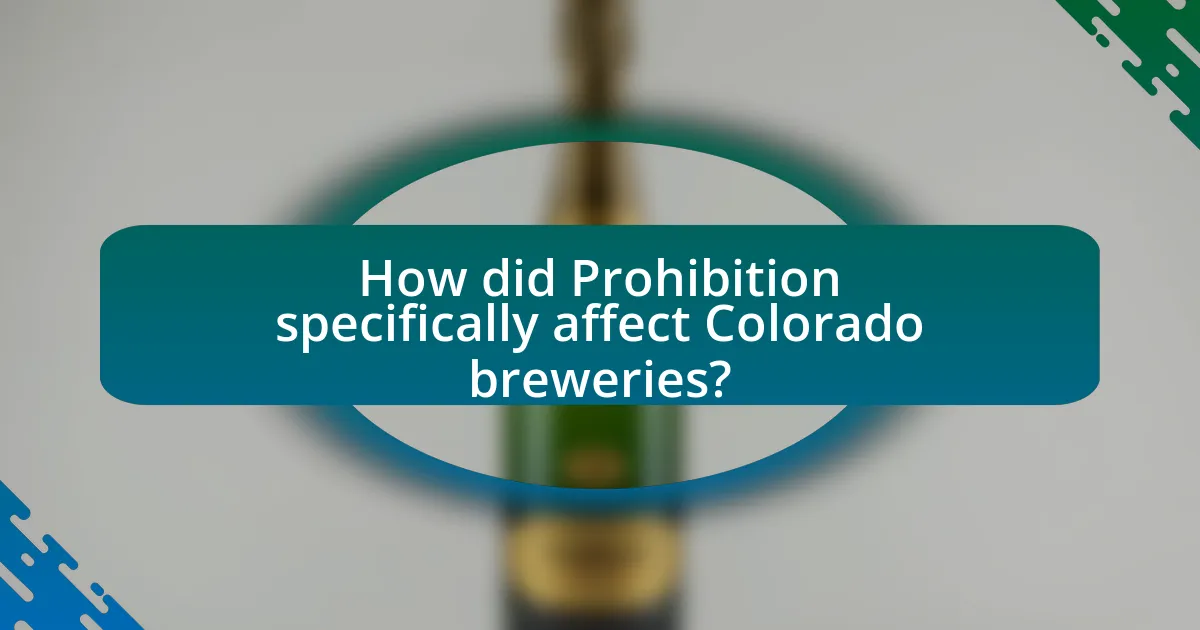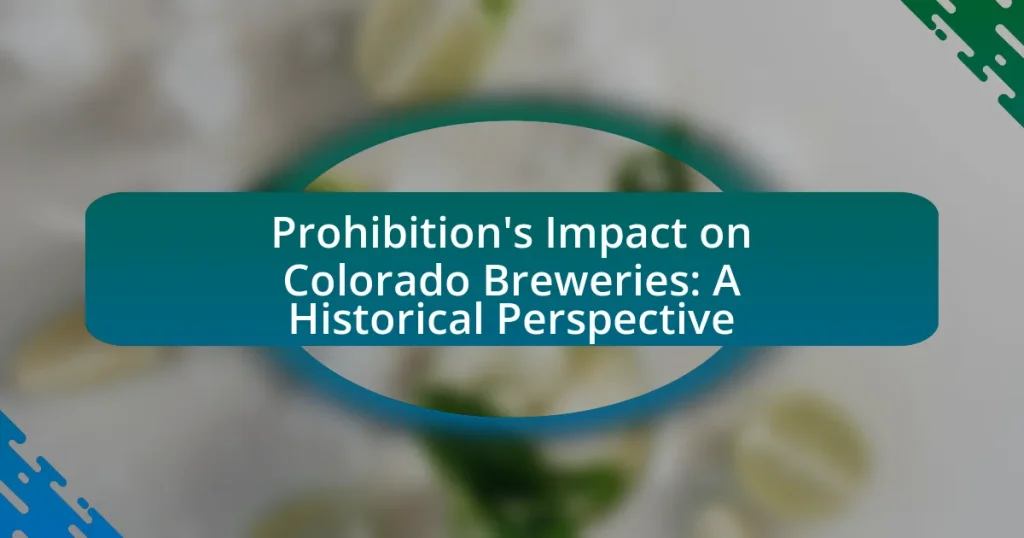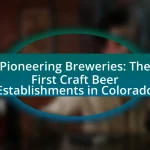Prohibition in the United States, enacted through the 18th Amendment in 1920, aimed to eliminate alcohol consumption due to its perceived social harms. This article examines the historical context of Prohibition, including the rise of the temperance movement, key events leading to the amendment’s passage, and the main proponents and opponents of the law. It further explores the immediate and long-term impacts of Prohibition on Colorado’s brewing industry, detailing how breweries adapted to survive, the changes in beer culture post-repeal, and the lessons learned from this period. The analysis highlights the significant decline of established breweries during Prohibition and the subsequent emergence of a vibrant craft brewing scene in Colorado.

What was the context of Prohibition in the United States?
Prohibition in the United States, enacted through the 18th Amendment in 1920, aimed to eliminate the consumption of alcohol due to concerns over its social effects. This movement was driven by various social and political groups, particularly the temperance movement, which argued that alcohol was responsible for crime, family violence, and moral decay. The Volstead Act defined intoxicating liquors and established enforcement mechanisms, leading to widespread illegal production and distribution of alcohol, known as bootlegging. By 1933, Prohibition was repealed with the 21st Amendment due to its failure to curb alcohol consumption and the rise of organized crime, highlighting the complexities and unintended consequences of such a sweeping social policy.
How did Prohibition come to be enacted?
Prohibition was enacted through the ratification of the 18th Amendment to the United States Constitution in 1919, which prohibited the manufacture, sale, and transportation of alcoholic beverages. This movement was largely driven by the temperance movement, which gained momentum in the late 19th and early 20th centuries, advocating for the reduction or elimination of alcohol consumption due to its perceived negative effects on society, including crime and family disintegration. The Volstead Act, passed in 1919, provided the legal framework for enforcing Prohibition, defining intoxicating liquors and outlining penalties for violations.
What were the key events leading to the passage of the 18th Amendment?
The key events leading to the passage of the 18th Amendment included the rise of the temperance movement, the influence of religious organizations, and the impact of World War I. The temperance movement gained momentum in the late 19th and early 20th centuries, advocating for the reduction or elimination of alcohol consumption due to its perceived negative effects on society. Organizations such as the Women’s Christian Temperance Union and the Anti-Saloon League played pivotal roles in mobilizing public support for prohibition. Additionally, during World War I, anti-German sentiment fueled opposition to breweries, many of which were owned by German-Americans, further pushing the agenda for prohibition. These combined factors culminated in the passage of the 18th Amendment in 1919, which established the legal prohibition of alcohol in the United States.
Who were the main proponents and opponents of Prohibition?
The main proponents of Prohibition included the Anti-Saloon League and the Women’s Christian Temperance Union, both advocating for the ban on alcohol due to its perceived social harms. The opponents of Prohibition were primarily brewers, distillers, and various immigrant groups who viewed the law as an infringement on personal freedoms and cultural practices. Historical context shows that the 18th Amendment, which enacted Prohibition in 1920, faced significant resistance from these groups, leading to its eventual repeal in 1933 with the 21st Amendment.
What were the intended goals of Prohibition?
The intended goals of Prohibition were to reduce crime, improve public morals, and promote health by banning the manufacture, sale, and transportation of alcoholic beverages. Prohibition aimed to eliminate the social problems associated with alcohol consumption, such as domestic violence and poverty, which were believed to be exacerbated by drinking. The 18th Amendment, ratified in 1919, and the Volstead Act, enacted in 1920, were legislative measures that enforced these goals, reflecting the influence of temperance movements and religious groups advocating for a sober society.
How did Prohibition aim to address social issues of the time?
Prohibition aimed to address social issues of the time by reducing alcohol consumption, which was associated with crime, domestic violence, and public disorder. The movement was driven by various social reformers who believed that banning alcohol would lead to a more moral and productive society. Historical evidence shows that organizations like the Women’s Christian Temperance Union advocated for Prohibition, arguing that alcohol was a root cause of societal problems, including poverty and family breakdown. The 18th Amendment, enacted in 1920, was a legislative attempt to eliminate these perceived social ills by prohibiting the manufacture, sale, and transportation of intoxicating liquors.
What economic factors influenced the push for Prohibition?
The economic factors that influenced the push for Prohibition included the desire to reduce the costs associated with alcohol-related social issues and the belief that banning alcohol would improve worker productivity. Advocates argued that alcohol consumption led to increased absenteeism and decreased efficiency in the workforce, which negatively impacted industrial productivity. Additionally, the temperance movement gained traction during economic downturns, as many believed that eliminating alcohol would alleviate poverty and reduce crime rates. Historical data indicates that the economic struggles of the early 20th century, particularly during the Great Depression, intensified calls for Prohibition as a means to foster a more productive and stable society.

How did Prohibition specifically affect Colorado breweries?
Prohibition severely impacted Colorado breweries by forcing many to close or drastically reduce operations. Between 1920 and 1933, the 18th Amendment prohibited the manufacture, sale, and transportation of alcoholic beverages, leading to the shutdown of numerous breweries in Colorado, such as the Denver-based Tivoli Brewing Company. By 1933, it is estimated that over 1,000 breweries nationwide ceased operations, with Colorado experiencing a significant decline in its brewing industry, which had previously been thriving due to the state’s rich brewing heritage. The economic consequences included job losses and a shift in consumer preferences, as many breweries attempted to survive by producing non-alcoholic products or pivoting to soft drinks.
What was the state of the brewing industry in Colorado before Prohibition?
Before Prohibition, the brewing industry in Colorado was thriving and rapidly expanding. By the early 1900s, Colorado had become home to numerous breweries, with Denver emerging as a significant center for beer production. The state boasted over 50 breweries by 1910, reflecting a diverse range of beer styles and a growing consumer base. This growth was supported by the influx of German immigrants who brought brewing traditions and techniques, contributing to a vibrant beer culture. The industry faced challenges, including competition and regulatory issues, but overall, it was characterized by innovation and a strong local market presence.
How many breweries existed in Colorado prior to the 18th Amendment?
Prior to the 18th Amendment, Colorado had approximately 50 breweries. This number reflects the vibrant brewing industry in the state during the late 19th and early 20th centuries, particularly in cities like Denver and Colorado Springs. The existence of these breweries contributed significantly to the local economy and culture before the onset of Prohibition, which drastically affected their operations and led to many closures.
What types of beer were popular in Colorado before Prohibition?
Before Prohibition, lagers were the most popular type of beer in Colorado. Specifically, German-style lagers, such as Pilsners and Märzen, dominated the brewing scene due to the significant German immigrant population in the state. These immigrants brought their brewing traditions, which heavily influenced local beer production. By the early 1900s, breweries like the Tivoli Brewing Company in Denver were well-known for their lagers, reflecting the preferences of the local populace.
What were the immediate impacts of Prohibition on Colorado breweries?
The immediate impacts of Prohibition on Colorado breweries included the closure of many establishments and a significant decline in beer production. Following the enactment of the 18th Amendment in 1920, Colorado breweries faced legal restrictions that forced them to shut down or pivot to producing non-alcoholic beverages. For instance, by 1921, over 90% of Colorado’s breweries had ceased operations, leading to job losses and economic downturns in the brewing industry. This drastic change illustrates the profound effect Prohibition had on the local brewing landscape, as many breweries could not survive the transition to a legal environment that prohibited their primary product.
How did breweries respond to the enactment of Prohibition?
Breweries responded to the enactment of Prohibition by either closing down, shifting to non-alcoholic products, or finding ways to circumvent the law. Many breweries ceased operations entirely, as the 18th Amendment and the Volstead Act made the production and sale of alcoholic beverages illegal starting in 1920. For instance, in Colorado, numerous breweries that could not adapt to the new legal landscape were forced to shut their doors permanently. Others, like the Coors Brewery, pivoted to producing near-beer and malted beverages, which were technically legal under Prohibition. Additionally, some breweries engaged in illegal production and distribution of alcohol, often referred to as bootlegging, to survive during this period. This multifaceted response illustrates the significant impact of Prohibition on the brewing industry, leading to a transformation in business models and operations.
What strategies did breweries employ to survive during Prohibition?
Breweries employed several strategies to survive during Prohibition, including diversifying their product offerings and transitioning to non-alcoholic beverages. Many breweries began producing soft drinks, near-beer, and malt extract, which were legal under Prohibition laws. For instance, in Colorado, some breweries shifted to producing soda and other non-alcoholic products, allowing them to maintain operations and retain their workforce. Additionally, some breweries capitalized on loopholes in the law, such as selling beer for “medicinal” purposes, which was permitted. These adaptations enabled breweries to navigate the challenges posed by Prohibition and sustain their businesses during this period.
What were the long-term effects of Prohibition on Colorado’s brewing landscape?
The long-term effects of Prohibition on Colorado’s brewing landscape included the significant decline of established breweries and the transformation of the industry towards smaller, craft operations. During Prohibition, which lasted from 1920 to 1933, many breweries were forced to close or pivot to producing non-alcoholic beverages, leading to a loss of jobs and a reduction in the brewing culture. After the repeal of Prohibition, the brewing industry in Colorado saw a resurgence, but it was characterized by the emergence of craft breweries rather than a return to the pre-Prohibition giants. By 2020, Colorado had over 400 breweries, reflecting a shift towards a diverse and innovative brewing scene that was shaped by the challenges and adaptations necessitated by Prohibition. This evolution illustrates how Prohibition not only disrupted the existing brewing landscape but also laid the groundwork for a new era of craft brewing in Colorado.
How did Prohibition reshape the brewing industry in Colorado post-1933?
Prohibition reshaped the brewing industry in Colorado post-1933 by allowing breweries to resume operations legally, leading to a significant revival and transformation of the sector. After the repeal of Prohibition, many breweries that had closed or shifted to producing non-alcoholic beverages reopened, such as the Coors Brewery, which expanded its production capacity. The industry also saw the emergence of new breweries, reflecting a diversification in beer styles and production methods. By 1935, Colorado had over 30 breweries, a notable increase from the pre-Prohibition era, indicating a robust recovery and growth in the market. This resurgence was characterized by a focus on quality and innovation, as breweries sought to capture the interest of consumers eager for legal beer after years of prohibition.
What changes occurred in the number of breweries after the repeal of Prohibition?
After the repeal of Prohibition in 1933, the number of breweries in the United States, including Colorado, significantly increased. Prior to Prohibition, there were approximately 1,500 breweries, but by 1935, the number had surged to around 750, indicating a rapid recovery and growth in the brewing industry. This resurgence was fueled by the demand for beer and the re-establishment of local breweries, which contributed to the revitalization of the economy and local communities.
How did the culture of beer consumption evolve in Colorado after Prohibition?
After Prohibition ended in 1933, the culture of beer consumption in Colorado transformed significantly, marked by a resurgence of local breweries and a growing appreciation for craft beer. The repeal allowed breweries to reopen, leading to the establishment of iconic brands like Coors, which began operations in 1873 and expanded its influence in the post-Prohibition era. By the late 20th century, Colorado became a hub for craft brewing, with the number of breweries increasing from just a handful in the 1980s to over 400 by 2020, reflecting a shift towards diverse beer styles and local ingredients. This evolution was further supported by the state’s favorable regulations and a community that embraced craft beer culture, culminating in events like the Great American Beer Festival, which began in 1982 and showcased Colorado’s brewing innovation.
What lessons can be learned from the impact of Prohibition on Colorado breweries?
The impact of Prohibition on Colorado breweries teaches the importance of adaptability and resilience in the face of regulatory challenges. During Prohibition, which lasted from 1920 to 1933, many breweries in Colorado were forced to close or pivot to producing non-alcoholic products, such as soft drinks and near-beer. This shift demonstrated that businesses can survive by diversifying their offerings and responding to changing legal landscapes. Additionally, the eventual repeal of Prohibition highlighted the significance of public demand for craft beer, leading to a resurgence of breweries in Colorado post-1933. This historical context underscores the necessity for breweries to remain flexible and innovative to thrive amid restrictive regulations.
How can current breweries apply historical insights from Prohibition?
Current breweries can apply historical insights from Prohibition by understanding the importance of adaptability and innovation in response to regulatory challenges. During Prohibition, many breweries pivoted to producing non-alcoholic beverages or diversified their product lines to survive, demonstrating the necessity of flexibility in business strategies. For instance, breweries like Coors shifted to producing malted milk and other products when beer production was banned, highlighting how diversification can mitigate risks associated with sudden market changes. This historical precedent emphasizes that modern breweries should remain agile and explore alternative revenue streams to navigate potential future regulations or market disruptions effectively.
What best practices emerged for breweries in response to Prohibition’s challenges?
Breweries adapted to Prohibition’s challenges by diversifying their product offerings and shifting to non-alcoholic beverages. Many breweries began producing soft drinks, near-beer, and malt extract to maintain revenue streams during the dry years. For instance, companies like Coors transitioned to producing malted milk and soda, which allowed them to survive the ban on alcohol. This strategic pivot not only helped breweries stay afloat but also laid the groundwork for their eventual resurgence after Prohibition ended in 1933.


